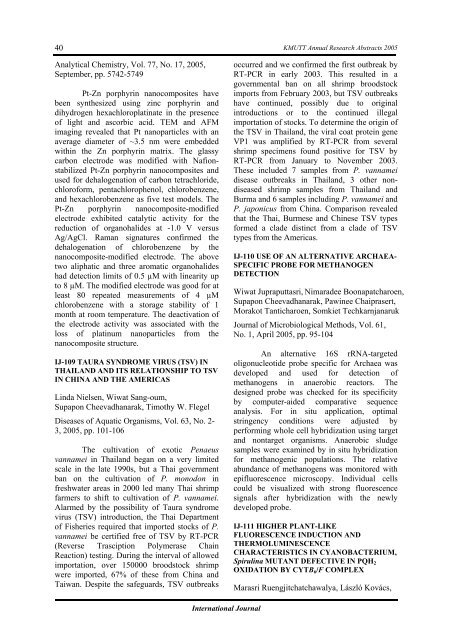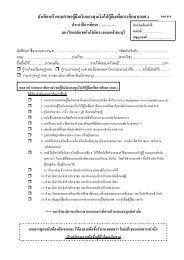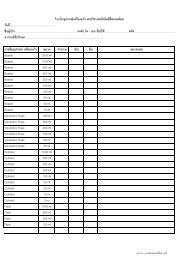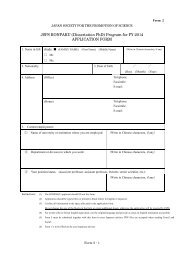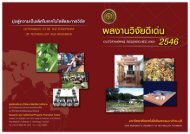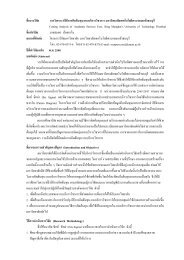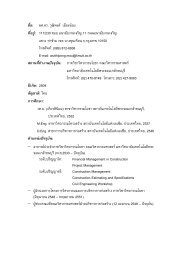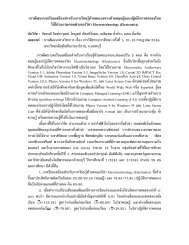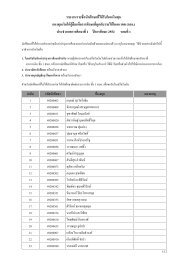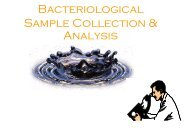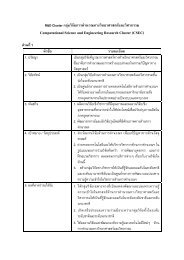Create successful ePaper yourself
Turn your PDF publications into a flip-book with our unique Google optimized e-Paper software.
40<br />
Analytical Chemistry, Vol. 77, No. 17, 2005,<br />
September, pp. 5742-5749<br />
Pt-Zn porphyrin nanocomposites have<br />
been synthesized using zinc porphyrin and<br />
dihydrogen hexachloroplatinate in the presence<br />
of light and ascorbic acid. TEM and AFM<br />
imaging revealed that Pt nanoparticles with an<br />
average diameter of ~3.5 nm were embedded<br />
within the Zn porphyrin matrix. The glassy<br />
carbon electrode was modified with Nafionstabilized<br />
Pt-Zn porphyrin nanocomposites and<br />
used for dehalogenation of carbon tetrachloride,<br />
chloroform, pentachlorophenol, chlorobenzene,<br />
and hexachlorobenzene as five test models. The<br />
Pt-Zn porphyrin nanocomposite-modified<br />
electrode exhibited catalytic activity for the<br />
reduction of organohalides at -1.0 V versus<br />
Ag/AgCl. Raman signatures confirmed the<br />
dehalogenation of chlorobenzene by the<br />
nanocomposite-modified electrode. The above<br />
two aliphatic and three aromatic organohalides<br />
had detection limits of 0.5 µM with linearity up<br />
to 8 µM. The modified electrode was good for at<br />
least 80 repeated measurements of 4 µM<br />
chlorobenzene with a storage stability of 1<br />
month at room temperature. The deactivation of<br />
the electrode activity was associated with the<br />
loss of platinum nanoparticles from the<br />
nanocomposite structure.<br />
IJ-109 TAURA SYNDROME VIRUS (TSV) IN<br />
THAILAND AND ITS RELATIONSHIP TO TSV<br />
IN CHINA AND THE AMERICAS<br />
Linda Nielsen, Wiwat Sang-oum,<br />
Supapon Cheevadhanarak, Timothy W. Flegel<br />
Diseases of Aquatic Organisms, Vol. 63, No. 2-<br />
3, 2005, pp. 101-106<br />
The cultivation of exotic Penaeus<br />
vannamei in Thailand began on a very limited<br />
scale in the late 1990s, but a Thai government<br />
ban on the cultivation of P. monodon in<br />
freshwater areas in 2000 led many Thai shrimp<br />
farmers to shift to cultivation of P. vannamei.<br />
Alarmed by the possibility of Taura syndrome<br />
virus (TSV) introduction, the Thai Department<br />
of Fisheries required that imported stocks of P.<br />
vannamei be certified free of TSV by RT-PCR<br />
(Reverse Trasciption Polymerase Chain<br />
Reaction) testing. During the interval of allowed<br />
importation, over 150000 broodstock shrimp<br />
were imported, 67% of these from China and<br />
Taiwan. Despite the safeguards, TSV outbreaks<br />
KMUTT Annual Research Abstracts 2005<br />
occurred and we confirmed the first outbreak by<br />
RT-PCR in early 2003. This resulted in a<br />
governmental ban on all shrimp broodstock<br />
imports from February 2003, but TSV outbreaks<br />
have continued, possibly due to original<br />
introductions or to the continued illegal<br />
importation of stocks. To determine the origin of<br />
the TSV in Thailand, the viral coat protein gene<br />
VP1 was amplified by RT-PCR from several<br />
shrimp specimens found positive for TSV by<br />
RT-PCR from January to November 2003.<br />
These included 7 samples from P. vannamei<br />
disease outbreaks in Thailand, 3 other nondiseased<br />
shrimp samples from Thailand and<br />
Burma and 6 samples including P. vannamei and<br />
P. japonicus from China. Comparison revealed<br />
that the Thai, Burmese and Chinese TSV types<br />
formed a clade distinct from a clade of TSV<br />
types from the Americas.<br />
IJ-110 USE OF AN ALTERNATIVE ARCHAEA-<br />
SPECIFIC PROBE FOR METHANOGEN<br />
DETECTION<br />
Wiwat Jupraputtasri, Nimaradee Boonapatcharoen,<br />
Supapon Cheevadhanarak, Pawinee Chaiprasert,<br />
Morakot Tanticharoen, Somkiet Techkarnjanaruk<br />
Journal of Microbiological Methods, Vol. 61,<br />
No. 1, April 2005, pp. 95-104<br />
An alternative 16S rRNA-targeted<br />
oligonucleotide probe specific for Archaea was<br />
developed and used for detection of<br />
methanogens in anaerobic reactors. The<br />
designed probe was checked for its specificity<br />
by computer-aided comparative sequence<br />
analysis. For in situ application, optimal<br />
stringency conditions were adjusted by<br />
performing whole cell hybridization using target<br />
and nontarget organisms. Anaerobic sludge<br />
samples were examined by in situ hybridization<br />
for methanogenic populations. The relative<br />
abundance of methanogens was monitored with<br />
epifluorescence microscopy. Individual cells<br />
could be visualized with strong fluorescence<br />
signals after hybridization with the newly<br />
developed probe.<br />
IJ-111 HIGHER PLANT-LIKE<br />
FLUORESCENCE INDUCTION AND<br />
THERMOLUMINESCENCE<br />
CHARACTERISTICS IN CYANOBACTERIUM,<br />
Spirulina MUTANT DEFECTIVE IN PQH 2<br />
OXIDATION BY CYTB 6 /F COMPLEX<br />
Marasri Ruengjitchatchawalya, László Kovács,<br />
International Journal


